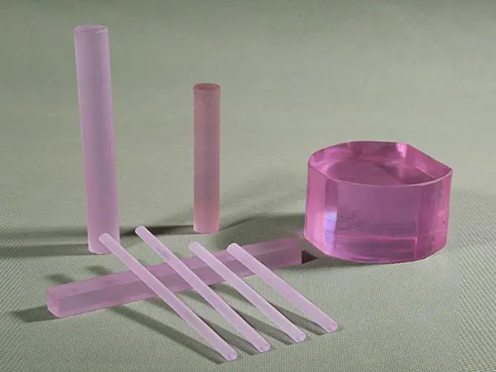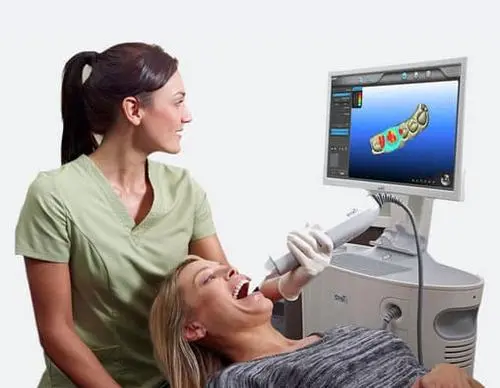Introduction to Nd-doped Yttrium Aluminum Garnet
neodymium-doped yttrium aluminum garnet (Nd:YAG) is a synthetic crystal employed as a lasing medium in high-powered solid-state lasers. Technically, Nd:YAG contains a precise ratio of neodymium, aluminum, and oxygen based on the formula Y3Al5O12. When stimulated, this crystal structure generates an infrared laser beam at 1064 nanometers, enabling surgical-grade cutting and ablation. Additionally, frequency-doubling the 1064nm wavelength produces visible green light at 532nm for photocoagulation. In summary, Nd:YAG's unique properties empower it as a versatile laser medium for diverse medical and industrial applications.
Specifically, triply-ionized neodymium Nd(III) acts as a dopant in Nd:YAG crystals. It actively replaces approximately 1% of the yttrium ions in the host yttrium aluminum garnet structure. This substitution is possible because the ionized neodymium and yttrium ions have similar sizes. Like chromium ions enable ruby lasers, neodymium ions empower the Nd:YAG crystal to emit a laser beam. The neodymium provides the critical lasing activity to generate 1064nm infrared light. In summary, the careful doping of Nd(III) into the YAG host crystal produces the specific lasing properties that make Nd:YAG ideal for surgical laser applications.

Manufacturers
actively produce neodymium-doped yttrium aluminum garnets with various doping
levels based on user specifications. In addition, many standard grade types
exist, including military-grade Mil-Spec, ACS, reagent, technical, food,
agricultural, and pharmaceutical grades. Specifically, industries and
businesses utilize Neodymium-doped Yttrium Aluminum Garnet (Nd:YAG) in diverse
applications. For example, Nd:YAG lasers have wide commercial use for cutting,
welding, drilling, and surface treatment. Furthermore, Nd:YAG laser
technologies serve emerging sectors like electric vehicle manufacturing.
Overall, manufacturers remain responsive to specific requirements when
producing doped YAG, while standardized grades address common industrial and
commercial needs. Undoubtedly, Neodymium-doped Yttrium Aluminum Garnet
continues finding extensive use across the manufacturing landscape.
Specifically, manufacturers optically pump Nd:YAG lasers using either flash tubes or laser diodes. When pumped, the lasers transition at wavelengths near 946, 1120, 1320, and 1440 nanometers. However, Nd:YAG lasers typically emit infrared light at 1064 nm. Additionally, they absorb light between 730-760 nm and 790-820 nm bands. In summary, the optical pumping technology enables the neodymium doped YAG lasers to emit strong infrared light at 1064 nm by absorbing specific wavelength bands. This technique allows for versatile use across industrial, scientific and commercial applications. Overall, precise doping combined with optical pumping gives Nd:YAG lasers unique capabilities highly valued for cutting-edge laser technologies.
Understanding Laser Technology for Medical Treatment
Although LASER stands for Light Amplification by Stimulated Emission of Radiation, people commonly use the term laser treatment to refer to cosmetic and medical applications. Specifically, healthcare professionals actively utilize laser technology to address various conditions and enhance procedures. For example, ophthalmologists harness lasers to correct poor vision through reshaping the cornea. Additionally, dermatologists employ laser treatment to remove tattoos, improve skin conditions, and perform facial rejuvenation. Furthermore, dentists use laser devices for tooth whitening and oral surgery. In summary, the precision, speed, and minimally invasive nature of lasers allow for diverse therapeutic and cosmetic treatments. Healthcare providers increasingly integrate laser-based solutions into practice to benefit patients.
In 1960, Theodore H. Maiman actively developed the first laser at Hughes Research Laboratories, inspired by the theoretical foundations of Charles Hard Townes and Arthur Leonard Schawlow. One common application of neodymium-doped yttrium aluminum garnet (Nd:YAG) is for laser treatments. Specifically, the unique properties of Nd:YAG enable its widespread medical usage. Doctors harness Nd:YAG lasers to remove tattoos, improve skin conditions, correct vision issues, and perform oral surgeries. Additionally, industries like automotive manufacturing and the military utilize Nd:YAG for cutting, welding, drilling, and other processes. However, the precision and minimally invasive nature of Nd:YAG lasers make them ideal for diverse medical applications. In fact, Nd:YAG lasers are a crucial laser treatment tool for dealing with tumors, lesions, and other medical conditions. Overall, while neodymium-doped yttrium aluminum garnet serves many functions, its ability to emit a strong infrared laser beam at 1064nm led to major therapeutic advancements in modern healthcare.
Simply put, Nd:YAG is integral to modern laser treatments. This neodymium-doped yttrium aluminum garnet laser enables precise, non-invasive procedures. Doctors harness Nd:YAG to address conditions without surgery. Uses include skin rejuvenation, vision correction, dental surgery, and more. In summary, Nd:YAG empowers key therapeutic laser applications
How to treat Nd:YAG laser

Medical professionals actively utilize Nd:YAG lasers to treat diverse conditions including pigmented lesions, vascular lesions, and tattoos. Specifically, urologists first harnessed the Nd:YAG laser in their field to achieve excellent hemostasis in patients, minimizing the need for postoperative bladder irrigation. Technically, Nd:YAG lasers employ a neodymium-doped crystal that generates invisible infrared light at 1064 nanometers continuously. Additionally, the 1064nm wavelength allows the beam to penetrate deep into tissue for optimal surgical results. Furthermore, the heat from Nd:YAG lasers coagulates tissue to stop bleeding rapidly. In summary, through precision and depth, the 1064nm Nd:YAG laser enables doctors to perform minimally invasive procedures not previously possible. Undoubtedly, this innovative laser technology empowers new therapeutic capabilities across medical specialties.
Here are some vital applications of Nd:YAG laser treatment:
Ophthalmology:doctors leverage YAG lasers for several procedures. Specifically, they use YAG to correct posterior capsular opacification following cataract operations. Additionally, the lasers effectively treat peripheral iridotomy in patients with acute or chronic angle-closure glaucoma. Furthermore, ophthalmologists harness YAG to address vitreous eye floaters and perform pan-retinal photocoagulation for proliferative diabetic retinopathy. In summary, the precision and control of YAG lasers enable ophthalmologists to successfully treat various posterior segment conditions without invasive surgery. Undoubtedly, this technology empowers new non-surgical options for managing eye diseases.
Thermotherapy: Specifically, 1064nm Nd:YAG lasers see widespread use in laser-induced thermotherapy. Doctors actively utilize these lasers to ablate benign and malignant lesions throughout the body. The 1064nm beam enables precise, minimally invasive destruction of unhealthy tissue. In summary, Nd:YAG lasers at this wavelength empower therapeutic ablation for diverse medical conditions.
Oncology: Specifically, doctors leverage Nd:YAG lasers to eliminate skin cancers. Additionally, they harness the technology to shrink benign thyroid nodules. Furthermore, Nd:YAG can destroy primary and secondary malignant liver lesions. In summary, the precision and control of these lasers allow for minimally invasive ablation of various cancers and tumors. Undoubtedly, Nd:YAG empowers new therapeutic options across medical specialties.
Cosmetology: In cosmetic medicine, doctors actively utilize Nd:YAG lasers for several procedures. Specifically, they harness Nd:YAG technology for laser hair removal treatments. Additionally, the lasers effectively treat minor vascular defects like facial and leg spider veins. They also address venous lake lip lesions. Recently, Nd:YAG lasers have been used to treat dissecting cellulitis of the scalp. In summary, the precision and control of Nd:YAG enables non-invasive remodeling of skin and vascular conditions. Undoubtedly, this versatile technology continues expanding treatment options in aesthetic medicine.
Hysteroscopy: doctors leverage Nd:YAG lasers with hysteroscopy to effectively remove uterine septa from inside the uterus. The combination of the flexible fiber-optic system and precise laser allows for non-invasive gynecological procedures. In summary, Nd:YAG and hysteroscopy enable innovative treatment of uterine conditions.
Podiatry: In podiatry, doctors utilize Nd:YAG lasers to treat toenail fungus infections known as onychomycosis. While more research could further demonstrate its benefits, the laser's precision enables non-invasive anti-fungal ablation. In summary, Nd:YAG technology shows promise for effectively managing foot conditions without surgery. Further studies will fully elucidate its therapeutic potential.
Laser Therapies Beyond Nd:YAG
Beyond Nd:YAG, various effective lasers are utilized in medicine, including:
l Doctors leverage infrared lasers to treat wrinkles caused by sun damage. The technology stimulates collagen production in the skin.
l Intense pulsed light breaks up skin pigment and removes discoloration. The bursts of high-intensity light specifically target melanin and redness.
l Radiofrequency tightens sagging and wrinkled skin areas. The energy heats tissue beneath the skin's surface to induce tightening and lifting effects.
l Other modalities include photodynamic therapy, CO2 lasers, ruby lasers, and fractional lasers. Each uniquely improves skin appearance and health.
